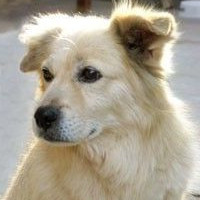 |
Chiribaya Dog |
|
He is not recognized by the F.C.I. |
Origin |
Peru | |
Translation |
Francis Vandersteen |
| The Chiribaya Dog (perro Chiribaya) or Peruvian Shepherd Dog (perro pastor Peruano) was a pre-Columbian breed of dog from southwestern Peru, identified by the 42 mummies discovered by anthropologist Sonia Guillén Oneglio in the Ilo district, Moquegua region, on Peru's south coast. It has been established that this was a llama herding dog. Dogs were not only an important part of the social structure of ancient Peruvians, but also received special treatment after death. The canine variety has been mentioned in various Spanish-language documentaries under different terms, such as el perro pastor Chribaya ("the Chiribaya shepherd dog") and the pastor Peruano ("Peruvian shepherd"), although the ancient Peruvians did not herd sheep. Its original name is unknown (it has been more ambiguously referred to as the perro Peruano or perro del Perú ("Peruvian dog", "dog of Peru"), but this has also been applied to an existing but ancient hairless variety, referred to in more detail as the perro sin pelo del Perú, "hairless dog of Peru", or the Peruvian hairless dog, a favorite in South American dog shows). The dogs were found buried in cemeteries alongside human mummies from the Chiribaya culture that flourished on Peru's southern coast, who appear to have buried their pets with all the honors of a faithful friend and colleague. The discovery is due to the research of Sonia Guillén, who specializes in the study of ancient mummies from the prosperous pre-Columbian cultures of the Chachapoyas on the shores of Moquegua. The mummies date from the "late" period, between 900 and 1350 CE. In the port area of Ilo is Mallqui Centre (from the Quechua word for "mummy"), dedicated to research into the Chiribaya culture. This society developed as a chiefdom. Their territory has a characteristic that makes all archaeologists dream: its soil is extremely dry and contains large quantities of nitrates, which ensures the preservation of the physical remains of those who inhabited this place. Sonia Guillén maintains that a person's grave reflects their social, political and religious position within their society. In the case of these dogs, the graves suggest that, having achieved a productive life in the Chiribaya civilization, they received good treatment, dead or alive. Ermanno Maniero, President of the Kennel Club of Peru, and Viviana Fernández, veterinarian at the National University of San Marcos, have carefully examined the mummies found and determined that these dogs had short legs and were longer than they were tall, had an abundant variety of coat colors that could vary from yellow to red, some with dark spots on the back or head, had cropped and shaved ears and had feet like those of a hare, enabling the animal to move over sand or soil with less effort, a quality perhaps important in the Chiribaya environment. In a report, the BBC reported even more characteristics: the dog was small, had a long muzzle, was beige in color, with long fur and resembled a small Golden Retriever. Chiribayas evolved in coastal regions, with the use of fishing and other marine resources, but also in agriculture, including the intensive use of livestock. Textiles and petroglyphs depict Chiribaya farming activity centered on the llama, underlining the importance of the "shepherd" dog in their society. According to research carried out by geneticist Jane Wheeler, who worked in the middle Ilo valley and studied the remains of the region's llamas and alpacas, the Chiribayas bred a type of llama with long, fine hair, but it was ignored by the Spanish conquerors, who used these llamas as pack animals, causing their disappearance. "Having so many llamas, the Chiribayas needed sheepdogs, and then they became collaborators with the people so that their deaths would produce honor," says Sonia Guillén. Martha Meier Miró Quesada, journalist, producer and documentary director, and her team were able to record Sonia Guillen's findings and investigations in images, and in 2006 produced a documentary entitled El Perro Pastor Chiribaya (The Chiribaya Sheepdog). The mummies of the Chiribaya dogs led researchers to initially hypothesize that descendants of the variety exist to this day. This seemed anecdotally confirmed by the similarity between the preserved remains and numerous dogs living in the port of Ilo, Tambo Valley, and the town of Mollendo (Arequipa Department). Even "Abdul", the guard dog at the Mallqui Center facilities, may have been descended from Chiribaya dogs. Its yellow fur, floppy ears and short muzzle match the characteristics of the mummies. Martha Meier drew attention to this detail, saying that local dogs called chusco match the known characteristics of a Chiribaya dog, so it wouldn't be surprising if over the years this had spread throughout Peru: "What we're doing now is recovering the purity of the dog breed, so let's start working to collect DNA from dogs in the Ilo region for comparison with the mummies, and then begin a selection and aging process. It will take several years to work, but it's worth it", says the filmmaker. However, the genetic study has not yet supported this idea. A study of the mitochondrial DNA of mummified Chiribaya dogs found three haplotypes, two of them never encountered before, and absent in samples of present-day dogs, and the other also in dogs on other continents. This suggests that modern dogs in the region are not closely related to ancient Chiribaya dogs. |






 English (United Kingdom)
English (United Kingdom)